An Embodied Carbon Assessment is a process that evaluates the carbon emissions generated during the early stages of a building or product’s lifecycle, from the extraction and processing of raw materials to their transportation and manufacturing. This method results in a detailed estimate of the total emissions, often referred to as the “cradle-to-gate” carbon footprint. By conducting such an assessment, businesses gain a clearer understanding of the environmental impact associated with their operations, allowing them to make strategic choices that support sustainability and reduce overall carbon output.
Through this comprehensive evaluation, organizations can take proactive steps toward reducing their environmental footprint while aligning with emerging sustainability goals. By analyzing emissions at the source, embodied carbon assessments help companies address the hidden environmental costs embedded in materials and processes, ultimately contributing to more sustainable production and construction practices.
Environmental Responsibility
Taking responsibility for the environmental impact of operations is increasingly becoming a priority for modern organizations. An embodied carbon assessment demonstrates a proactive approach to sustainability, signaling that the organization values ecological stewardship. As awareness grows among consumers, showing dedication to reducing environmental harm can enhance reputation, build trust, and attract a broader audience that prefers sustainable products and services. This commitment not only contributes to a healthier planet but also strengthens the ethical foundation of the business.
Regulatory Compliance
Environmental regulations concerning carbon emissions are becoming more stringent in many parts of the world. Conducting an embodied carbon assessment helps organizations stay ahead of evolving legal requirements by ensuring compliance with regional, national, or international environmental standards. This can prevent regulatory issues down the line, reducing the risk of penalties and avoiding the costs associated with retroactive compliance efforts. Furthermore, being compliant helps reinforce a company’s position as a responsible industry leader.
Cost Reduction
Understanding where emissions originate within the supply chain and production process often reveals inefficiencies that can be addressed to lower operational costs. Embodied carbon assessments provide insights into energy use, material waste, and transportation inefficiencies, allowing organizations to make strategic adjustments. These optimizations can lead to lower utility bills, streamlined operations, and overall resource conservation—delivering long-term financial savings in addition to environmental benefits.
Risk Mitigation
Climate-related risks such as supply chain instability, increased production costs, and reputational damage are growing concerns for businesses worldwide. An embodied carbon assessment allows organizations to identify weak points in their processes that may be vulnerable to such risks. By understanding the carbon intensity of each step in the value chain, companies can make targeted improvements to build resilience, reduce exposure to environmental and social risks, and adapt more effectively to the challenges of a changing climate.
Competitive Advantage
Sustainability has become a critical factor in consumer purchasing decisions and business partnerships. Organizations that prioritize reducing their carbon footprint can stand out from competitors by promoting responsible practices. This reputation for environmental integrity can open doors to new markets, attract environmentally conscious consumers, and enhance partnerships with other sustainable-minded companies. A strong sustainability profile often translates to increased brand loyalty and a greater share of market interest.
Product Innovation
By revealing inefficiencies and high-impact processes, embodied carbon assessments serve as a catalyst for rethinking design and production methods. This often sparks innovation, encouraging the development of new materials, products, or systems that perform better with less environmental cost. Over time, this focus on innovation can lead to the creation of more advanced and eco-friendly solutions, setting the company apart as a leader in sustainable development and modern design thinking.
Investor and Stakeholder Relations
As environmental, social, and governance (ESG) criteria play a larger role in investment decisions, transparent reporting through embodied carbon assessments is becoming more valuable. Investors, shareholders, and business partners increasingly seek alignment with organizations that prioritize sustainability. Clear, data-backed carbon reporting demonstrates accountability and long-term planning, which can help attract investment, secure funding, and strengthen relationships with key stakeholders.
Employee Engagement
A company’s values can significantly influence its internal culture. Demonstrating a genuine commitment to sustainability through embodied carbon assessments can have a positive impact on employee morale and engagement. Workers often feel more motivated and take pride in contributing to an environmentally responsible organization. This sense of purpose not only improves retention and satisfaction but also fosters a workplace culture grounded in collective responsibility and shared goals.
Long-Term Viability
In a global economy shifting toward greener practices and low-carbon strategies, businesses that fail to measure and reduce their carbon emissions risk falling behind. Embodied carbon assessments provide a roadmap for future-proofing operations by identifying areas for improvement and supporting long-term environmental strategies. Taking action today helps ensure that a company remains relevant and resilient as environmental priorities and regulations continue to evolve.
In summary, incorporating Embodied Carbon Assessments into business strategy empowers organizations to make informed, forward-thinking decisions that benefit the planet and their bottom line. From enhancing innovation and reducing costs to improving stakeholder trust and ensuring long-term viability, the advantages of assessing embodied carbon are both immediate and enduring.



